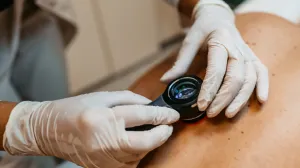
Nancy Rutherford's husband, Gary, vividly remembers the frustration. “We saw so many doctors,” he said. No one had an answer. We tried everything.”
Desperate for relief, Gary asked his cardiologist at Tufts Medical Center, Carey Kimmelstiel, MD if he could recommend someone—anyone—who might help. That’s when they were referred to dermatologist Sandhya Deverapalli, MD, who, in Gary’s words, "changed everything."
When skin speaks
When Dr. Deverapalli met Nancy in 2020, she quickly realized something deeper was going on. The severity and stubbornness of the skin lesions didn’t match any ordinary dermatologic condition. Nancy’s skin wasn’t just reacting—it was signaling. Dr. Deverapalli ordered a battery of tests, including nearly 20 vials of bloodwork, and prescribed a few topical treatments, though they provided little relief.
As time passed and nothing improved, Dr. Deverapalli kept digging. Her research led her to medical literature suggesting a rare link between certain dermatologic symptoms and smoldering multiple myeloma (SMM)—a precancerous blood disorder where abnormal plasma cells build up in the bone marrow. While typically asymptomatic, SMM can progress to multiple myeloma, a serious form of blood cancer.
I told oncology, ‘You need to look at this.' I had run out of dermatologic options, and I suspected that her skin symptoms were connected to an underlying hematologic condition.
Sandhya Deverapalli, MD, dermatologist
She provided research papers and case studies supporting the connection and oncology confirmed that the ulcers were a rare manifestation of smoldering multiple myeloma.
A turning point
With a diagnosis in hand, Nancy’s care shifted dramatically. While steroids had provided some temporary relief, they were just dousing flames without addressing the fire’s source. The real change came when Nancy began treatment targeted at the disease driving her skin symptoms from within.
She began receiving daratumumab, a monoclonal antibody used to treat multiple myeloma—not the usual steroid shots that come with significant long-term risks like bone thinning and compression fractures.
Most people would have never connected the dots. But Dr. Deverapalli didn’t stop until she did.
Gary Rutherford, husband of patient
Nancy's case is a reminder that skin can often be a window into deeper health issues. “This was a condition that had been there for years,” said Dr. Deverapalli. “It required stepping back, thinking bigger and listening closely.”
The bigger picture
Today, Nancy receives her injections twice a month, and her symptoms are finally under control. She’s able to travel again—without pain and without needing to hide her feet. And her journey has added another case to the still-growing body of evidence linking dermatologic conditions to systemic diseases like multiple myeloma.
Dr. Deverapalli hopes this story reminds physicians across specialties to collaborate, communicate and always be willing to look deeper.
“Sometimes the skin is telling you something,” she said. “You just have to be willing to listen.”


